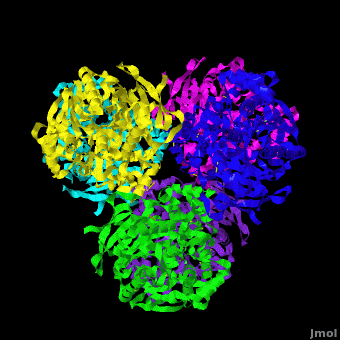Function
Carboxylesterase (CE) catalyzes the conversion of a wide variety carboxylic esters to alcohol and carboxylate. The catalytic triad of CE involves serine, glutamic acid or aspartic acid and histidine. Human CE1 (hCE1) is involved in drug metabolism and activation. It catalyzes the hydrolysis of heroin and cocaine.
Human carboxylesterase 1 (rhCES1) has been produced in and isolated from whole Trichoplusia ni larvae. The recombinant protein was crystallized and its structure was solved to 2.2 Å resolution (4ab1). The current structure of rhCES1 represents the first published hexagonal crystal form, despite the fact that all other published examples of hCES1 structures consist of a hexamer in the asymmetric unit. found in this space group, while the three twofold axes at z = 1/4 that intersect on this axis complete the . An gave an r.m.s. deviation of 0.42 Å for 522 Cα atoms (2h7c is colored in red and rhCES1 is in green). An r.m.s. value of 0.47 Å (3132 Cα atoms) was obtained for the , indicating that the quaternary structure is essentially identical in these crystal forms isolated from cultured Sf21 cells, supporting the use of this expression system to produce recombinant enzymes for crystallization studies.
Regions of the current structure that differ from the previously reported examples of hCES1 include Ser365–Asp374, which has very poor density. In the 2h7c structure . The poorly defined density for this same region in rhCES1 is consistent with the observation that (the loop of one subunit is in red and the loop of the second subunit is in orange).
The current results confirm that rhHCES1 isolated from the T. ni system is essentially identical to previous examples of this enzyme isolated from cultured insect cells, validating the use of the whole insect system as a source for recombinant proteins in structure determination studies.[1]
Palmitoleoyl-protein carboxyl esterase NOTUM mediates depalmitolyation of Wnt proteins[2].
For the hydrolysis of cocaine by CE see Cocaethylene Synthesis and Pathophysiology.
3D structures of Carboxylesterase
Carboxylesterase 3D structures

